A tire’s speed rating indicates the optimal speed that the tire can safely maintain over time. In short, it’s the fastest speed a tire can handle before it no longer performs as designed. The higher the speed rating, the better control and handling you’ll have at higher speeds.
The speed rating system was developed to help control the safe performance of tires at standardized speeds. A tire’s certified speed rating is given a letter from A to Z, ranging from 5km/h (3mph) to above 300 km/h (186 mph).
This rating system (see below) shows the top speed for which a tire is certified. It does not indicate the total performance capability of a tire.
The speed rating system used today was developed in Europe in response to the need to control the safe performance of tires at standardized speeds. When the rating system was originally developed, the "Unlimited V" category of over 210 km/h (130 mph) was the top speed rating possible.
As manufacturers developed bigger and better tires, it became necessary to regulate performance at standardized speeds to ensure safety. The "Limited V" category of 250 km/h (149 mph) was then created, and eventually the "Z" speed rating was added as the top speed rating. (Always consult the manufacturer for the maximum speed of Unlimited Z tires.)
You can find your tire speed rating in a number of places, typically in the owner’s manual, driver’s side doorjamb, glove box door, and gas tank hatch. Recent standardization has changed so all ratings except "Unlimited ZR" incorporate the speed symbol and load index as part of every tire’s service description on the tire’s sidewall. If you’re reading your tire sidewall, the speed rating will be the last item in the character sequence in the tire’s size code. Below is an example of a the description on a tire’s sidewall: 2015/60R15 91V. Here, the tire would have a speed rating of V. V-rated tires can be driven at 149 MPH.
Below is an example of a the description on a tire’s sidewall: 2015/60R15 91V. Here, the tire would have a speed rating of V. V-rated tires can be driven at 149 MPH.
TIRE DESCRIPTION
| 205/60R15 91V | |
|---|---|
| 205 = Section Width in Millimeters | |
| 60 = Aspect Ration | |
| R = Radial Construction | |
| 15 = Rim diameter in Inches | |
| 91 = Load Index | Service Description |
| V = Speed Symbol | |
Tires having a maximum speed capability over 149 MPH may have “ZR” in the size designation. Tires with a maximum speed capability over 186 MPH are required to include “ZR” in the designation. Below are examples of tire sizes with a “ZR” speed rating.
ZR DESIGNATION
| EXAMPLES | |
|---|---|
| Tire Designation | Maximum Speed |
| P275/40ZR17 93W | 270 km/h (168 mph) |
| P275/40ZR17 93Y | 300 km/h (186 mph) |
For tires with a maximum speed capability higher than 240 km/h (149 mph), a "ZR" may appear in the size designation.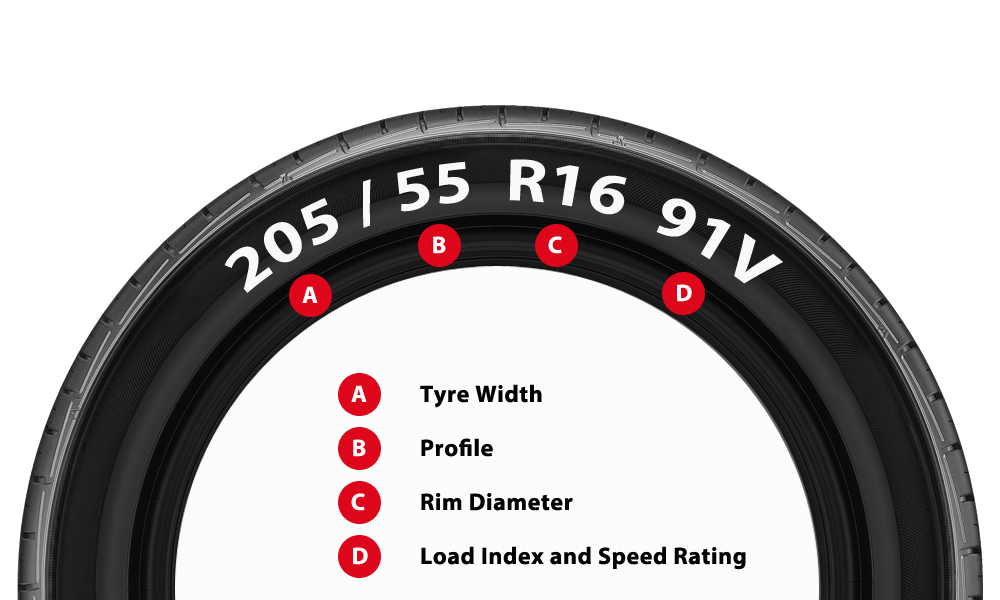 Tires with a maximum speed capability higher than 300 km/h (186 mph), require a "ZR" in the size designation. Consult the tire manufacturer for maximum speed when there is no service description.
Tires with a maximum speed capability higher than 300 km/h (186 mph), require a "ZR" in the size designation. Consult the tire manufacturer for maximum speed when there is no service description.
TIRE SPEED CAPABILITIES
| SPEED SYMBOLS | ||
|---|---|---|
| Symbol Speed | Speed (km/h) | Speed (mph) |
| A1 | 5 | 3 |
| A2 | 10 | 6 |
| A3 | 15 | 9 |
| A4 | 20 | 12 |
| A5 | 25 | 16 |
| A6 | 30 | 19 |
| A8 | 40 | 25 |
| B | 50 | 31 |
| C | 60 | 37 |
| D | 65 | 40 |
| E | 70 | 43 |
| F | 80 | 50 |
| G | 90 | 56 |
| J | 100 | 62 |
| K | 110 | 68 |
| L | 120 | 75 |
| M | 130 | 81 |
| N | 140 | 87 |
| P | 150 | 94 |
| Q | 160 | 100 |
| R | 170 | 106 |
| S | 180 | 112 |
| T | 190 | 118 |
| U | 200 | 124 |
| H | 210 | 130 |
| V | 240 | 149 |
| W | 270 | 168 |
| Y | 300 | 186 |
Need help understanding the speed rating on tires? Our technicians have got you covered.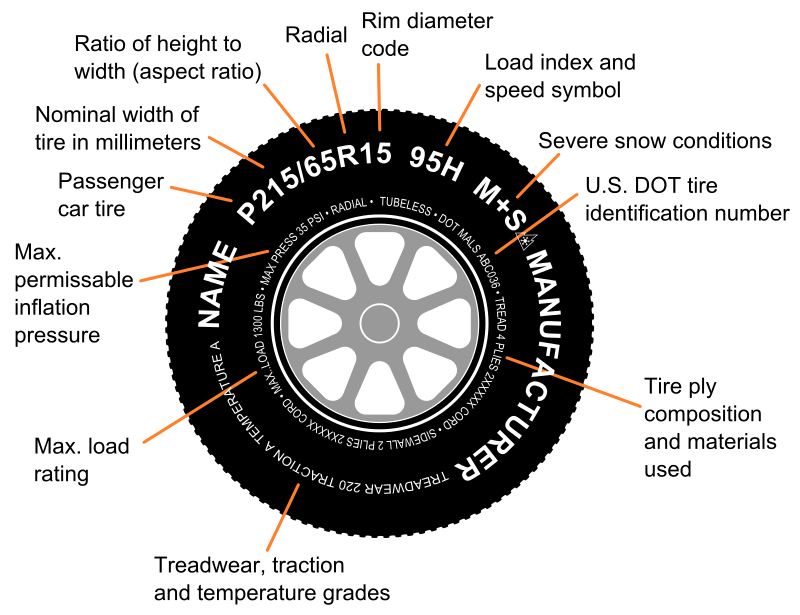 Bring your vehicle by your local Tires Plus and we’ll help you understand your tire numbers, tire size, and more!
Bring your vehicle by your local Tires Plus and we’ll help you understand your tire numbers, tire size, and more!
{{storeNumber}}
{{storeName}}
{{link-icon "Call Us" mobileCallLink null "call-cta"}} {{link-icon "Directions" directions "_blank" "directions-cta"}}
{{address}}
{{city}}, {{state}} {{zip}}
{{#if activeFlag}} {{#ifCond mystore "or" myPreferredStore}} {{#ifCond storeType 'eq' "TPL"}}
*Call store for appointment {{phone}}
{{else}} {{#if onlineAppointmentActiveFlag }}
{{#if myPreferredStore}}
{{else}}
*Call store for appointment {{phone}}
{{/if}} {{/ifCond}} {{else}} {{#ifCond storeType 'eq' "TPL"}}
*Call store for appointment {{phone}}
{{else}}
Schedule Appointment {{#if onlineAppointmentActiveFlag}} {{else}}
*Call store for appointment {{phone}}
{{/if}}
{{/ifCond}} {{/ifCond}} {{else}}
*Temporarily Closed Due To: {{temporarilyClosedReason}}
{{/if}} {{#if isMilitaryStore}}
*This location is on an active US military base.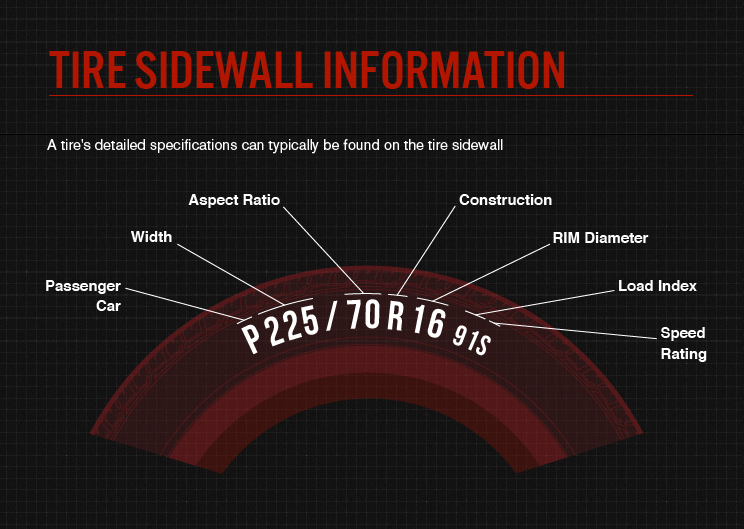 You may need military ID to access the location.
You may need military ID to access the location.
{{/if}}
Most modern passenger tires bear a tire speed rating, a designation indicating the tire’s designed speed capability. In other words, it’s the fastest speed a tire can handle before it does not perform as designed. Tire speed ratings do not imply that the vehicle may safely be driven at the maximum speed for which the tire is capable, particularly under adverse weather or road conditions.
Find Your Tire
If you’re wondering what tire speed rating your vehicle manufacturer recommends, simply look in the manual. You might also find it in the driver’s side door jamb, the gas tank hatch, or inside the glove box door – anywhere that lists the right tire code for your vehicle.
Speed rating is easy to locate because it’s usually the last item in the character sequence in the tire’s size code. For example in this tire code: “P205/60R16 82S,” S is the speed rating. To view the tire size code for your current tires, just look at the sidewall. Does the speed rating on each tire match what the manufacturer recommends? It should!
For example in this tire code: “P205/60R16 82S,” S is the speed rating. To view the tire size code for your current tires, just look at the sidewall. Does the speed rating on each tire match what the manufacturer recommends? It should!
Also remember that the tire speed rating isn’t the same thing as a recommended travel speed. The rating will nearly always exceed maximum highway speed limits, but no tire or vehicle manufacturer advises driving faster than the law allows.
Speed ratings are the product of laboratory testing – with simulated speeds and loads. To receive any kind of rating, a tire must demonstrate that it’s capable of sustaining a particular speed. Industry standards govern the process of reaching and maintaining a given speed during a test.
However, it’s important to remember that the lab can’t simulate every conceivable condition. Think of your tire’s speed rating as an indicator of the product’s capability under controlled conditions (i. e. fully inflated, vehicle running properly, good weather conditions). Your tires’ actual speed capability may be less than its rated speed, since it is affected by factors such as inflation, wear, vehicle condition (including alignment), driving conditions and the duration at which speed is maintained. Speed ratings do not apply to tires that have been damaged, altered, under-inflated, overloaded or repaired.
e. fully inflated, vehicle running properly, good weather conditions). Your tires’ actual speed capability may be less than its rated speed, since it is affected by factors such as inflation, wear, vehicle condition (including alignment), driving conditions and the duration at which speed is maintained. Speed ratings do not apply to tires that have been damaged, altered, under-inflated, overloaded or repaired.
High performance driving all year long
See Tire Details This Tire Fits Your Vehicle See a map of stores near you where you can buy this tire
See Tires That Fit Does Not Fit Your Vehicle
See if it Fits Not Sure If This Tire Fits
Take control of the track
See Tire Details This Tire Fits Your Vehicle See a map of stores near you where you can buy this tire
See Tires That Fit Does Not Fit Your Vehicle
See if it Fits Not Sure If This Tire Fits
Sleek, sporty, and cornering performance
See Tire Details This Tire Fits Your Vehicle See a map of stores near you where you can buy this tire
See Tires That Fit Does Not Fit Your Vehicle
See if it Fits Not Sure If This Tire Fits
Take your sports car for a spin
See Tire Details This Tire Fits Your Vehicle See a map of stores near you where you can buy this tire
See Tires That Fit Does Not Fit Your Vehicle
See if it Fits Not Sure If This Tire Fits
Feel the rush with tires inspired by racing
See Tire Details This Tire Fits Your Vehicle See a map of stores near you where you can buy this tire
See Tires That Fit Does Not Fit Your Vehicle
See if it Fits Not Sure If This Tire Fits
Chase your competitive spirit
See Tire Details This Tire Fits Your Vehicle See a map of stores near you where you can buy this tire
See Tires That Fit Does Not Fit Your Vehicle
See if it Fits Not Sure If This Tire Fits
Impressive grip and control
See Tire Details This Tire Fits Your Vehicle See a map of stores near you where you can buy this tire
See Tires That Fit Does Not Fit Your Vehicle
See if it Fits Not Sure If This Tire Fits
Today’s speed rating system uses letters A through Z.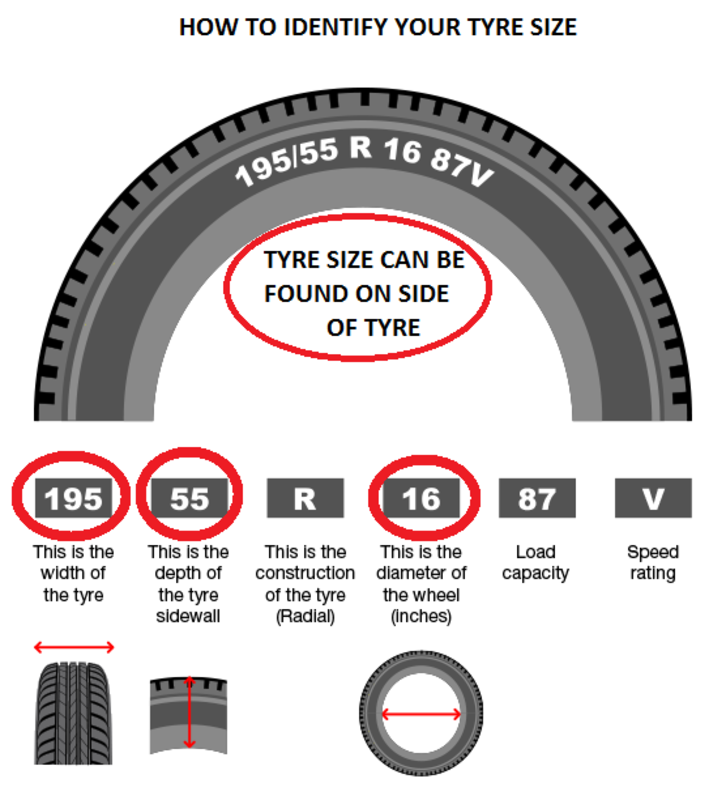 Each letter corresponds to a specific speed. In general, that speed goes up as the rating advances alphabetically. For example, a tire rated “L” is good for a lower maximum sustained speed than one rated “N.”
Each letter corresponds to a specific speed. In general, that speed goes up as the rating advances alphabetically. For example, a tire rated “L” is good for a lower maximum sustained speed than one rated “N.”
But the tire speed rating system isn’t without its quirks. For instance, the system’s European roots give it unusual mile per hour maximums. Another such quirk is that the letter “H” is out of place. Instead of appearing after “G,” it falls between “U” and “V” as does the speed to which it corresponds.
Additional speed rating “anomalies” include the following:
“I,” “O,” and “X” speed ratings don’t exist. Likewise, some speed rating charts don’t include the “P” rating.
Tires with the lowest speed ratings are usually listed as “A” followed by a number– for example, “A1,” “A2, “A3,” and so on.
Some tires carry “W” or “Y” speed ratings. Manufacturers may also insert “Z” into the size description (in the tire code data between aspect ratio and diameter) for these kinds of tires.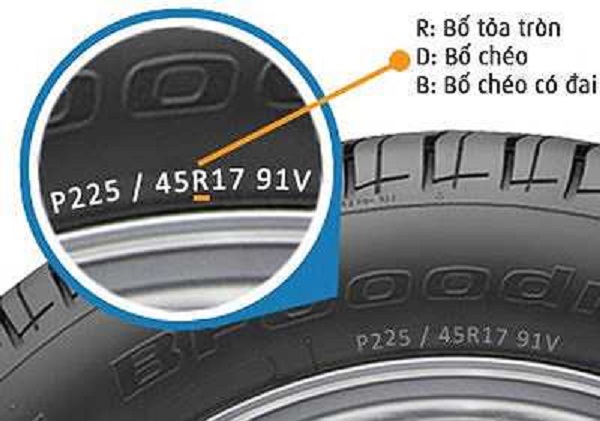
When the speed rating system was first developed, the highest speed rating was the unlimited “V” rating. This was for tires whose maximum sustained speed was 149 mph (240 kph) or more. Then, as more manufacturers came out with tires that could handle speeds in excess of 149 mph but still hit a maximum speed at some point, “V” became limited (149 mph instead of 149+ mph) and “W” and “Y” speed ratings were added to the chart.
Many tire speed rating charts also list the “Z” rating as anything over 149 mph. Some manufacturers will insert a “Z” in the middle of the tire size description (right after the aspect ratio) when the tire is rated at “W” or “Y.” And if a tire is rated in excess of 186 mph (300 kph), manufacturer’s usually will list a “Z” within the size description, per industry standards.
EXPLORE PERFORMANCE TIRESThe following speed ratings are those you’re most likely to encounter for ordinary vehicles.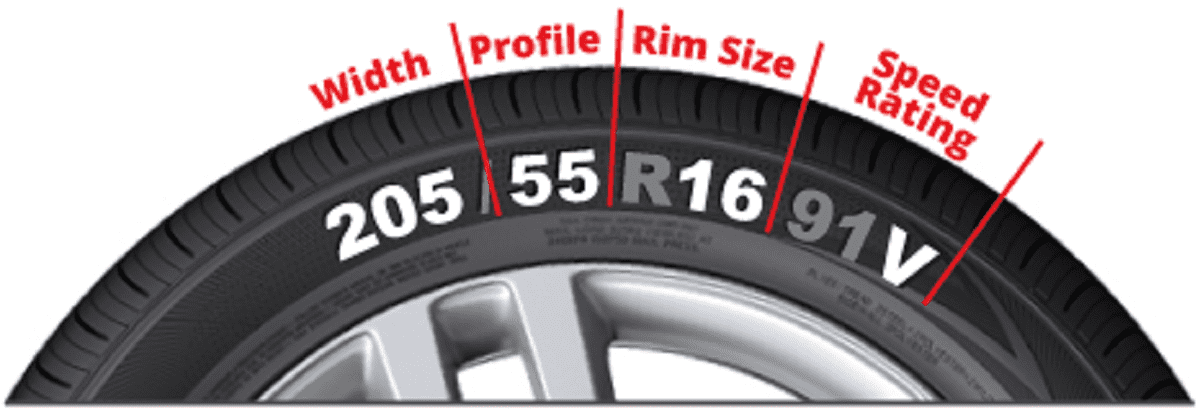 They begin with a maximum speed of 118 mph (190 kph) and increase from there.
They begin with a maximum speed of 118 mph (190 kph) and increase from there.
Indicated by a letter, each rating corresponds to a specific speed.
With a maximum speed of 118 mph, you usually find tires with speed rating “T” on family sedans and minivans.
If you recall from earlier, the “H” speed rating doesn’t appear after “G” but between “U” and “V.” It represents a maximum speed of 130 mph (210 kph) and is commonly found on sports sedans and coupes. In earlier incarnations of the speed rating system, “H” stood for “high performance,” which is why it maintains an unusual position in the speed rating spectrum today.
Once the highest speed rating a tire could have, “V” used to represent a maximum of 149 mph (240 kph) or more. Nowadays, it means 149 mph but no higher.
A relatively new addition to the speed rating chart, tires with speed rating “W” can achieve a maximum sustained speed of 168 mph (270 kph).
A “Z” rating can mean different things. While it nearly always means a high performance tire for high-performing sports cars, “Z” may actually appear in the middle of a tire’s size information. When it does, it represents either a maximum speed of more than 149 mph (240 kph) or 186 mph (300 kph). Which of those speeds it refers to will depend on the specific tire. Contact the manufacturer to get details on any Z-rated tires. Sports car owners are more likely to encounter this speed rating than owners of typical family sedans.
Always choose the speed rating that corresponds to your vehicle manufacturer’s specifications, and be sure all four tires have the same rating. Speed ratings are based on laboratory tests under specific, controlled conditions. While these tests relate to performance on the road under those conditions, remember that real-life driving is rarely identical to test conditions.
Find Your Tire
03/20/2021
The specialists of the Volkswagen branded service will help you understand the designations of the symbols printed on the tire, so that it would be easier for you to choose “shoes” for your car.
| Marking | Key |
|---|---|
| Tire (brand, logo) | Manufacturer |
| Name (product name) | The individual tire name given by the manufacturer |
| P255/ 55 R 18 | Size designation |
| P | Car marking |
| 255 | Tire width from one sidewall to another, mm |
| 55 | Relative profile height (ratio of height to width, %) |
| R | Code letter for radial tire |
| eighteen | Rim diameter in inches |
| 109 N | Load Index* and Speed Index** |
| M+S or M/S | Letter designation of tires suitable for winter conditions |
| Radial Tubeless | Tubeless radial tires |
| E4 | International designation (E) with the number of the country of issue of the permit. Followed by a multi-digit authorization number Followed by a multi-digit authorization number |
| DOT BT TY5 1709 | Tire identification number TIN - can only be on the inside of the tire and date of manufacture: |
| DOT | The tire complies with the requirements of the UWB Department of Transportation, which approves the safety standards for tires |
| BT | Letter designation of the manufacturer |
| RA | Manufacturer's tire size designation |
| TY5 | Designation of distinguishing features of the tire by the manufacturer |
| 1709 | Date of manufacture: 17th week of 2009 |
| TWI | Location of wear indicators |
| SIDEWALL 1 PLY PAYON | Sidewall composition: 1 layer of viscose |
| TREAD 4PLIES 1 PAYON+ 2 STEEEL + 1 NYLON | Breaker composition: In the example, there are 4 layers under the tread: 1 layer of viscose, 2 layers of radial steel cord, 1 layer of nylon |
| TREADWEAR 220 | Relative design life of the tire according to the American standard test |
| TRACTION A | Wet braking capability (AA, A, I or C) |
| TEMPERATURE A | Resistance to heat at high speeds on the test bench (A, B or C).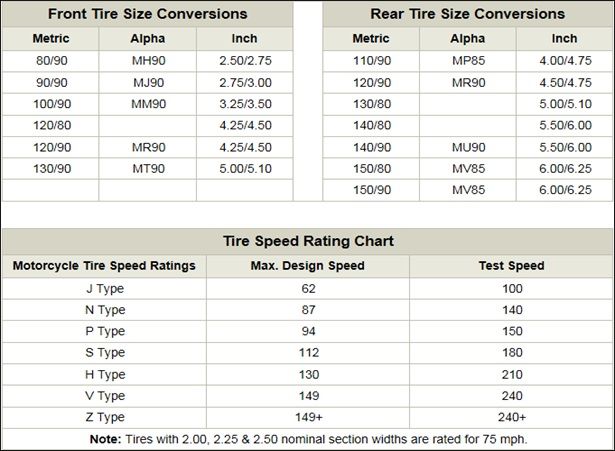 |
Indicates the maximum load the tire is designed for.
Indicates the maximum speed the tire is designed for.
For those who are used to deciding on their own the issue of competent selection of tires for their car, we have prepared useful information in this section:
tire design differences.
Types of tire marking and interpretation of its meanings.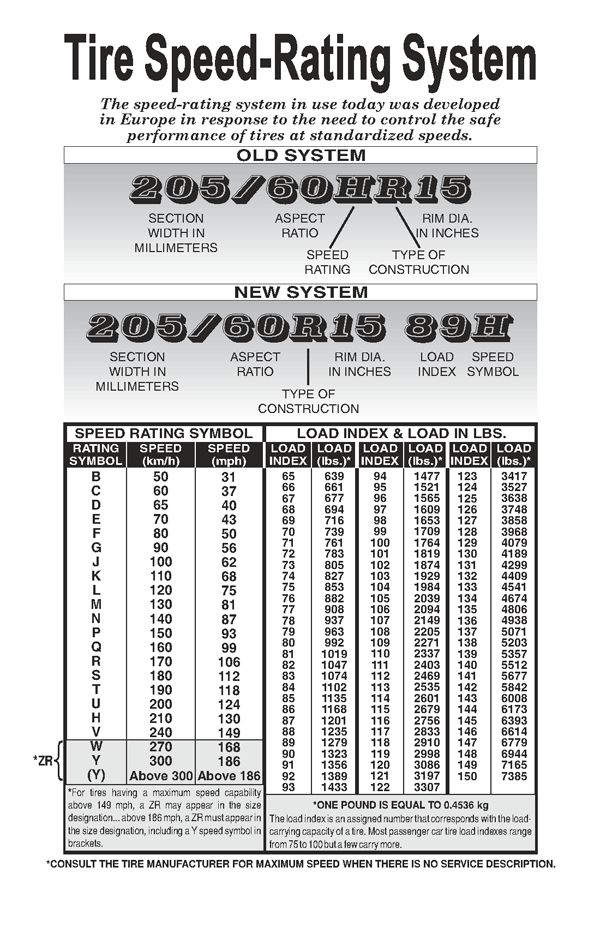
Types of car tire designs.
Rubber and cord are, of course, the main ones in the production of car tires. Rubber made from natural and/or synthetic rubber is reinforced with cord fabric, which. In turn, it can be made of metal, textile or polymer threads.
The figure shows the classic car tire structure:
1 - tread
2 - shoulder
3 - carcass
4 - side (fender)
5 - belt and cushion layer
6 - additional insert in the shoulder area
7 - side ring
8 - side part
According to the method of sealing the wheel, tires are divided into chamber and tubeless:
Tube tires consist of several elements: tires, chambers with a valve, with which air enters the tire and blocks its exit to the outside, and a rim tape that is put on the rim to prevent the tube from rubbing against the wheel and tire edge.
Tubeless tires differ from tube tires in the presence of a sealing rubber layer, which is applied to the first layer of the carcass.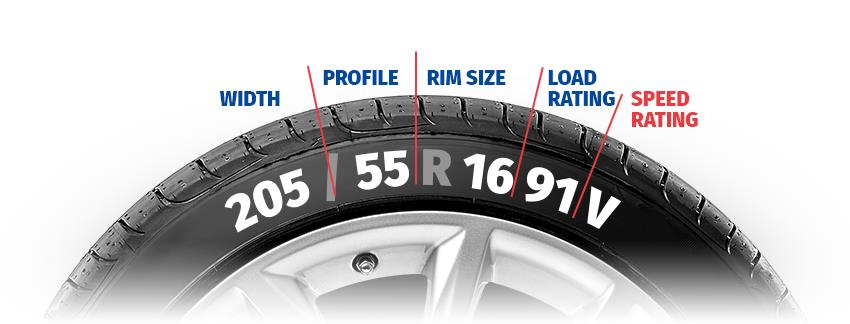 The camera is missing. The state of tightness in them is achieved due to the tight fit of the tire on the rim. The tire inflation valve is located in the wheel rim hole, which reduces tire weight, improves safety in case of a tire puncture, improves heat transfer, and also simplifies tire repair.
The camera is missing. The state of tightness in them is achieved due to the tight fit of the tire on the rim. The tire inflation valve is located in the wheel rim hole, which reduces tire weight, improves safety in case of a tire puncture, improves heat transfer, and also simplifies tire repair.
Most modern car tires are tubeless.
Depending on the location of the cord threads in relation to the radius of the wheel, tires are divided into radial and diagonal.
Bias tire carcass is a set of rubberized cord spacers, the edges of which are wrapped around wire ring rods (they are what allow the tire to “plant” on the rim). The carcass and breaker cords are crossed in adjacent layers (the number of adjacent layers is usually four) at an angle of 45° - 60°.
Today, this type of tire design is obsolete. As a rule, such tires are used on old cars, while in view of the still considerable fleet and demand for them, as well as the low cost of production, tires with a diagonal cord arrangement continue to be produced. It is worth noting the high maintainability of such tires, as well as resistance to destruction from impacts and cuts.
It is worth noting the high maintainability of such tires, as well as resistance to destruction from impacts and cuts.
The carcass of a radial tire is a structure with a parallel arrangement of the tire cords (along the radius from one bead to the other, and the breaker cords at an angle of more than 65°). In order for the tire to withstand heavy loads at high speeds and sharp turns, it has a steel cord belt in which two layers are wound alternately at a sharp angle. An additional nylon band is used on certain models to further stabilize the behavior of the tire.
Today, tires with a radial arrangement of cords are most in demand due to improved characteristics: structural rigidity, stability of the tire contact patch with the roadway, reduced rolling resistance and, as a result, lower fuel consumption. At the same time, tires with a radial design have a lower weight and carcass thickness, heat up less, give off heat faster, which can significantly extend their service life.
By purpose, the tires are divided into the following groups:
tires for passenger cars;
tires for light trucks and SUVs.
tires for trucks;
tires for construction, agriculture and special purpose of technology.
tires for motorcycles and mopeds.
In the production of passenger and light truck tires, a cord made of textile or polymer threads is used.
Metal cord used in the production of truck tires.
TIRE MARKING.
On November 1, 2012, a law on mandatory tire labeling was passed in Europe. Tires for passenger cars, commercial vehicles and trucks produced in the European Union have a standardized marking. It should be taken into account that the law does not provide for mandatory marking of retreaded tires, off-road tires, tires for cars registered before October 1, 1990, as well as for spare tires and stowaways, tires with a speed index below 80 km / h, studded tires, tires for racing cars.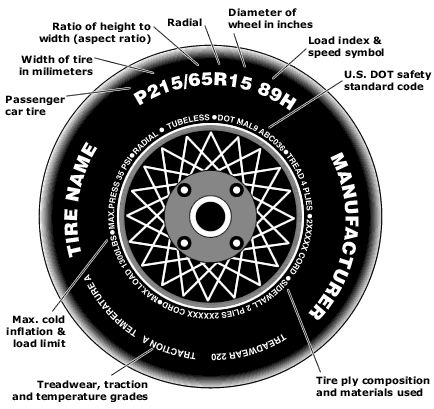
In summary, according to the European label, tires must be judged on three main criteria: fuel efficiency, wet grip, and external rolling noise.
Fuel Efficiency (Rolling Resistance)
The fuel efficiency of is an important criterion to consider when choosing a tire. The argument here is quite weighty - about twenty percent of a car's fuel consumption depends on the tires used! The higher the rolling resistance rating of a tire, the higher your vehicle's fuel consumption will be. The level of tire rolling resistance is indicated in Latin letters in the range from A to G. Accordingly, the mark A on the tire indicates low rolling resistance, and therefore the lowest fuel consumption. The G mark indicates the highest level of tire rolling resistance, of course, fuel consumption will be maximum.
What determines the rolling resistance index? A number of determining factors come into play here:
the design of the tire itself.
tire pressure level.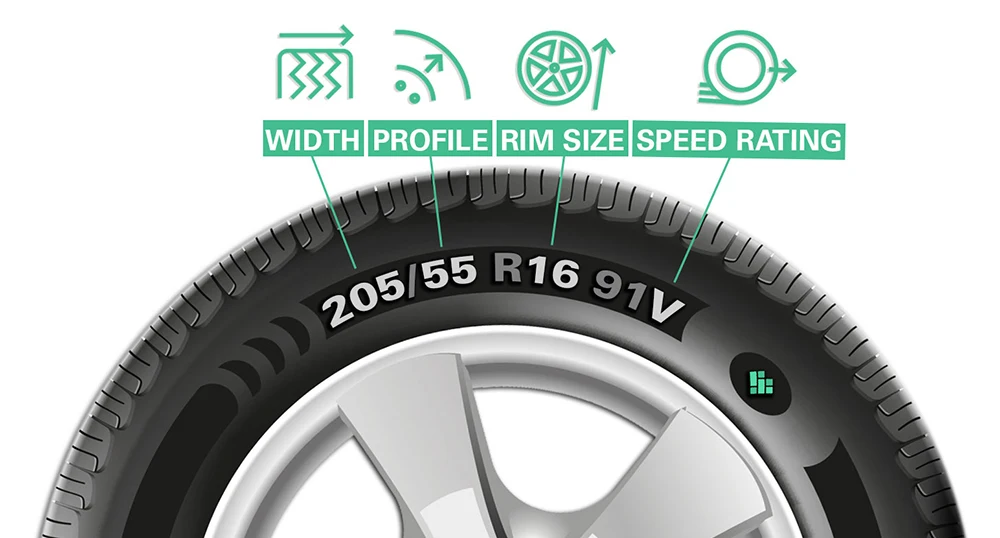
tire temperature and load.
vehicle speed.
the condition of the suspension of the car and the roadway.
Wet grip .
This criterion evaluates the stopping distance of a vehicle on a wet road surface. Tires are marked with Latin letters in the range from A to F. The difference in the braking distance of a car equipped with category A tires and category F tires will be about eighteen meters (according to measurements made on a car moving at a speed of 80 km / h before braking).
External tire rolling noise.
This indicator indicates the noise level that occurs when a tire is rolling and is measured in decibels. The quietest tires do not exceed 60 dB. Tires over 74 dB will be very noisy.
METRIC AND TIRE LABELING.
Winter - tires designed for operation in winter weather conditions.
Aqua, Rain or Water (may be designated with an umbrella icon) - Tires designed for use in rain or wet conditions. Minimize the effect of aquaplaning, especially at high speeds.
Minimize the effect of aquaplaning, especially at high speeds.
M + S (Mud + Snow, which means mud + snow) - off-road tires for driving in mud or snow.
M/T (Mud Terrain) - mud terrains.
A/T (All Terrain) - tires for any type of terrain.
AS (All Season), Any Season, R+W (Road + Winter) - designations for all-season tires.
Rotation - Tires with directional tread patterns have an arrow on the sidewall of the tire indicating the desired direction of tire rotation.
Outside and Inside (or Side Facing Out and Side Facing Inwards) are asymmetric tires, which must be installed strictly following the tire-on-rim rule. The inscription Outside (outer side) should be on the outside of the car, and Inside (inner side) - on the inside.
Left or Right - means that the tires of this model are left and right. When installing them, you must strictly follow the rule of installing a tire on a car, the left ones only on the left, and the right ones, respectively, only on the right.
Steel Radial - a radial tire with a steel cord.
Tubeless (TL) - tubeless tire.
Tube Type (TT) - the tire is installed with the camera.
Treadwear 380 - wear coefficient, determined in relation to the "base tire", for which it is equal to 100. The wear index is a theoretical value and cannot be directly related to the practical life of the tire, which is significantly influenced by road conditions, driving style, following pressure recommendations, adjusting vehicle camber angles and wheel rotation. The wear indicator is presented as a number from 60 to 620 with an interval of 20 units. The higher its value, the longer the protector withstands when tested according to the established method.
Traction A - friction coefficient, has the values A, B, C. Coefficient A has the highest friction value in its class.
Max Load - the maximum load and further there are values in kilograms and pounds.
PR (Ply Rating) - the strength (load-bearing capacity) of the carcass is conditionally estimated by the so-called ply rate. The stronger the carcass, the more air pressure the tire can withstand, and therefore has a greater load capacity. For passenger cars, tires with a ply rating of 4PR and sometimes 6PR are used, and in this case the latter have the inscription "Reinforced", that is, "reinforced" (tires with increased load capacity).
The stronger the carcass, the more air pressure the tire can withstand, and therefore has a greater load capacity. For passenger cars, tires with a ply rating of 4PR and sometimes 6PR are used, and in this case the latter have the inscription "Reinforced", that is, "reinforced" (tires with increased load capacity).
Extra Load (XL) - increased load index.
Reinforced (Reinf or RF) - increased load index. On light trucks and minibuses, tires with 6PR and 8PR are most commonly used. The increased ply (that is, strength) of the tire may be indicated by the letter “C” (commercial), which is placed after the designation of the landing diameter (for example, 185R14C).
TWI - the mark is located on the sidewall of the tire and shows the location of the remaining tread height marks in the main grooves. For the countries of the European Union and the Russian Federation, the remaining tread depth of a worn passenger tire must be at least 1.6 mm.
ZP (Zéro Pression) - zero pressure, Michelin's commercial designation for tires with reinforced sidewalls. ZP: Ability to continue driving in the event of a puncture up to 80 km at speeds up to 80 km/h. ZP SR: Ability to continue driving in the event of a puncture up to 30 km at speeds up to 80 km/h.
ZP: Ability to continue driving in the event of a puncture up to 80 km at speeds up to 80 km/h. ZP SR: Ability to continue driving in the event of a puncture up to 30 km at speeds up to 80 km/h.
SST(Self Supporting Tires) - self-supporting tire. Such tires can carry the load and continue to move after a puncture.
Dunlop MFS (Maximum Flange Shield) - Maximum bead protection system protects expensive wheels from curbs and pavement damage - a rubber profile around the tire circumference, located on the bottom of the wall above the rim flange, forms a buffer zone.
Studless - the tire cannot be fitted with studs.
Studdable - Tire can be fitted with studs. In addition, the tires are marked with quality standards
E (circled) - European quality standard.
DOT - American Quality Standard.
SPEED INDEX.
As a result of tests carried out by the manufacturer on a specially equipped stand, each tire is assigned a certain speed category. The marking on the tire indicates the maximum speed that the tire of this model can withstand. When choosing tires, this factor should be taken into account, since your car should drive at a speed of 10-15% less than the maximum allowable.
The marking on the tire indicates the maximum speed that the tire of this model can withstand. When choosing tires, this factor should be taken into account, since your car should drive at a speed of 10-15% less than the maximum allowable.
Marking "ZR" - indicates that the tires are designed for operation at speeds exceeding 240 km/h.
The “V” marking on a tire, together with the load index (example: 91V), means that the tires are designed for use at speeds up to 240 km/h, while the load index is indicated for a speed of 210 km/h. The load must be reduced by three percent in proportion to the increase in speed by 10 km/h.
The "W" marking on the tires, together with the load index (example: 100W), indicates that the tire is designed for use at speeds up to 270 km/h, while the load index is indicated for a speed of 240 km/h. The load must be reduced by five percent in proportion to the increase in speed by 10 km/h.
The "Y" marking on a tire with a load rating (example: 95Y) indicates that the tires are designed for speeds up to 300 km/h, while the load rating is for 270 km/h.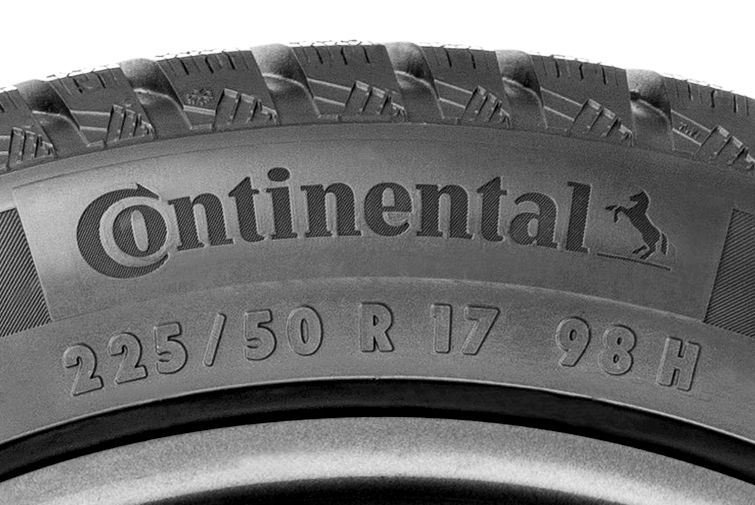 The load must be reduced by five percent in proportion to the increase in speed by 10 km/h.
The load must be reduced by five percent in proportion to the increase in speed by 10 km/h.
LOAD INDEX.
| Load index | Permissible load, kg | Load index | Permissible load, kg |
|---|---|---|---|
| 0 | 45 | 100 | 800 |
| 1 | 46.2 | 101 | 825 |
| 2 | 47.5 | 102 | 850 |
| 3 | 48.7 | 103 | 875 |
| 4 | 50 | 104 | 900 |
| 5 | 51.5 | 105 | 925 |
| 6 | 53 | 106 | 950 |
| 7 | 54. | 107 | 975 |
| 8 | 56 | 108 | 1000 |
| 9 | 58 | 109 | 1030 |
| 10 | 60 | 110 | 1060 |
| 11 | 61.5 | 111 | 1090 |
| 12 | 63 | 112 | 1120 |
| 13 | 65 | 113 | 1150 |
| 14 | 67 | 114 | 1180 |
| 15 | 69 | 115 | 1215 |
| 16 | 71 | 116 | 1250 |
| 17 | 73 | 117 | 1285 |
| 18 | 75 | 118 | 1320 |
| 19 | 77. | 119 | 1360 |
| 20 | 80 | 120 | 1400 |
| 21 | 82.5 | 121 | 1450 |
| 22 | 85 | 122 | 1500 |
| 23 | 87.5 | 123 | 1550 |
| 24 | 90 | 124 | 1600 |
| 25 | 92.5 | 125 | 1650 |
| 26 | 95 | 126 | 1700 |
| 27 | 97 | 127 | 1750 |
| 28 | 100 | 128 | 1800 |
| 29 | 103 | 129 | 1850 |
| 30 | 106 | 130 | 1900 |
| 31 | 109 | 131 | 1950 |
| 32 | 112 | 132 | 2000 |
| 33 | 115 | 133 | 2060 |
| 34 | 118 | 134 | 2120 |
| 35 | 121 | 135 | 2180 |
| 36 | 125 | 136 | 2240 |
| 37 | 128 | 137 | 2300 |
| 38 | 132 | 138 | 2360 |
| 39 | 136 | 139 | 2430 |
| 40 | 140 | 140 | 2500 |
| 41 | 145 | 141 | 2575 |
| 42 | 150 | 142 | 2650 |
| 43 | 155 | 143 | 2725 |
| 44 | 160 | 144 | 2800 |
| 45 | 165 | 145 | 2900 |
| 46 | 170 | 146 | 3000 |
| 47 | 175 | 147 | 3075 |
| 48 | 180 | 148 | 3150 |
| 49 | 185 | 149 | 3250 |
| 50 | 190 | 150 | 3350 |
| 51 | 195 | 151 | 3450 |
| 52 | 200 | 152 | 3550 |
| 53 | 206 | 153 | 3650 |
| 54 | 212 | 154 | 3750 |
| 55 | 218 | 155 | 3875 |
| 56 | 224 | 156 | 4000 |
| 57 | 230 | 157 | 4125 |
| 58 | 236 | 158 | 4250 |
| 59 | 243 | 159 | 4375 |
| 60 | 250 | 160 | 4500 |
| 61 | 257 | 161 | 4625 |
| 62 | 265 | 162 | 4750 |
| 63 | 272 | 163 | 4875 |
| 64 | 280 | 164 | 5000 |
| 65 | 290 | 165 | 5150 |
| 66 | 300 | 166 | 5300 |
| 67 | 307 | 167 | 5450 |
| 68 | 315 | 168 | 5600 |
| 69 | 325 | 169 | 5800 |
| 70 | 335 | 170 | 6000 |
| 71 | 345 | 171 | 6150 |
| 72 | 355 | 172 | 6300 |
| 73 | 365 | 173 | 6500 |
| 74 | 375 | 174 | 6700 |
| 75 | 387 | 175 | 6900 |
| 76 | 400 | 176 | 7100 |
| 77 | 412 | 177 | 7300 |
| 78 | 425 | 178 | 7500 |
| 79 | 437 | 179 | 7750 |
| 80 | 450 | 180 | 8000 |
| 81 | 462 | 181 | 8250 |
| 82 | 475 | 182 | 8500 |
| 83 | 487 | 183 | 8750 |
| 84 | 500 | 184 | 9000 |
| 85 | 515 | 185 | 9250 |
| 86 | 530 | 186 | 9500 |
| 87 | 545 | 187 | 9750 |
| 88 | 560 | 188 | 10000 |
| 89 | 580 | 189 | 10300 |
| 90 | 600 | 190 | 10600 |
| 91 | 615 | 191 | 10900 |
| 92 | 630 | 192 | 11200 |
| 93 | 650 | 193 | 11500 |
| 94 | 670 | 194 | 11800 |
| 95 | 690 | 195 | 12150 |
| 96 | 710 | 196 | 12500 |
| 97 | 730 | 197 | 12850 |
| 98 | 750 | 198 | 13200 |
| 99 | 775 | 199 | 13600 |
More information.
Tires must be marked as follows:
MAX PRESSURE - the maximum allowable tire pressure. For each type of tire, there are air pressure standards that must be observed. Violation of these requirements can lead to both increased or uneven wear of the tread, and a violation of the integrity of the tire, which is dangerous especially at high speeds. By the way, before adjusting the wheel alignment of the car - do not forget to bring the tire pressure back to normal!
What are the colored dots or circles on the tire for?
The red dot indicates the hardest point on the tire. If your rims are marked with a white dot, it is recommended to combine these two dots during tire fitting.
The yellow dot indicates the lightest spot on the tyre.
To a greater extent, both markings are needed for tire service employees, because this information will tell a competent specialist how to reduce the mass and number of balancing weights.
Tire construction materials - Tires may also bear the names of the materials that make up the tire carcass and breaker.
Here is an example of tire marking and its interpretation:
Metric marking system.
Example: TIRE LT205/55R16 91V
for trailers/semi-trailers and vans (these tires are not used for cars/trucks/SUVs; T - temporary use tire (for spare wheel)
205 - profile width in mm
55 - ratio of tire profile height to tire width.
R - the type of tire carcass has a radial structure (the absence of a default marking indicates that the tire is a diagonal type).
D (or not specified) - diagonal tire carcass type.
B - Bias Belt. The structure of the tire carcass is diagonal with the use of a breaker, characteristic of radial tires.
16 — tire diameter in inches (corresponds to the diameter of the rim).
91 - maximum load index. Marking is also used indicating the load in kg or pounds (max load).
V - tire speed index (see the value in the table).
The following marking options are also possible:
The location of the speed index designation is allowed in different places: 225/50SR16, 225/50SR16 89S, 225/50R16 89S
Marking with the letter C after the diameter indicates that the tire is intended for commercial vehicles , as well as off-road trucks and pickups (example: 195/70R15C 104/102R).
If the manufacturer, after indicating the tire size, placed the letters XL, RF, SL, LL (example: P235 / 75R-15 XL, P285 / 35R-19 LL), this means that the tire has XL, RF - increased, SL - standard, LL - reduced bearing capacity. American P-marking XL corresponds to the maximum allowable pressure of 41 psi (280 kPa), SL and LL - 35 psi (240 kPa), in the European marking XL / RF corresponds to 42 psi (290 kPa), SL - 36 psi (250 kPa), LL is missing. The absence of this designation corresponds to the SL variant.
The presence of the letters FR (example: 215/45 R17 87V FR) after the specified size means that the tire has a protective portico on the sidewall that protects the rim and the rubber itself from damage.